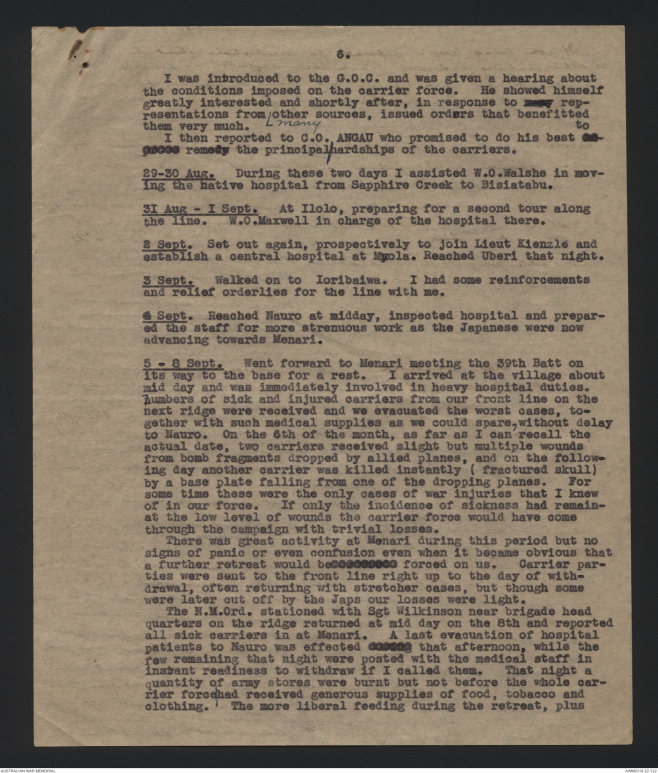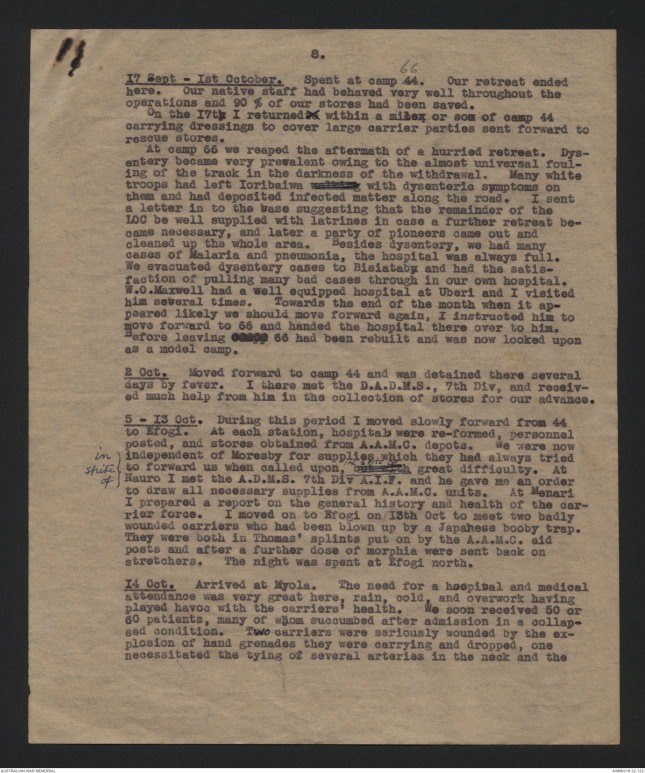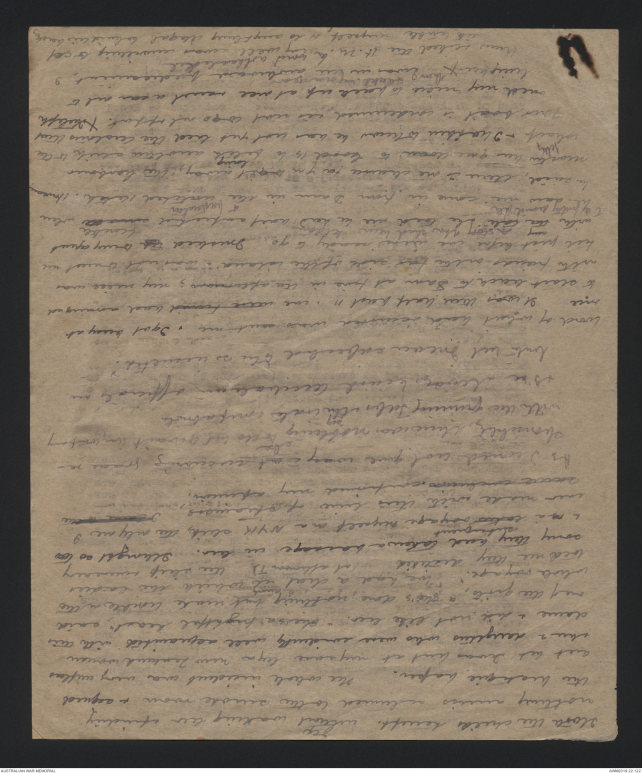Diary of Geoffrey Hampden Vernon - Part 2










5.
II) - I4 Aug. Attending to sick and wounded white troops and
obtaining the release of a few carriers on the grounds of broken
health. Went forward one day to Isuravi and met Capt MacLaren
there.
I5th Aug. Returned to Myola, halting at Templeton's X to inspect
our hospital where we have one N½M½Ord stationed. On the
way up the hill, Brigadier Potts stopped me and made some inquiries
about the state of the carriers.
We now had a hospital at Myola with one N.M.Ord and Lieut Kienzle
wished me to get back there as soon as possible to enlarge
it as a central hospital for carriers. As elsewhere in these
early days, Myola was poorly supplied with drugs; we signalled
O.C. N½M.S. to send supplies by air as from here we could restock
other centres. After some delay, drugs were sent here
but they arrived long after I had left.
I6th Aug. Walked to Efogi passing 53rd batt who looked very
spent going forward.
I7-23 Aug.17 Aug. Relieved W.O. Barnes at Efogi and sent him to the base
for rest and re-equipment. Re-formed the hospital and established
an isolation camp for Dysentery which was very prevalent.
Owing to the large numbers of white troops passing through Efogi,
chiefly A.I.F., there were insufficient latrines and the area
was becoming fouled. White and native pioneers were set to digging
new ones. We were badly in need of drugs at Efogi and great
economy in their use was necessary. On the 23rd I went to Efogi
north to superintend the digging of latrines for carriers reinforcements
expected from Moresby.
24 Aug. Walked to Menari with a number of selected C. class carriers
unfit for further service. I obtained some drugs at Menari
from army supplies and was able to replenish our stocks here
and at Efogi. Arrive Nauro I700.
25 Aug. Walked to Ioribaiwa in company with Major Cameron who
was on his record breaking journey from Deniki to Port Moresby,
completed in one hour less than three days.
The sanitation at Ioribaiwa was now in a deplorable state
owing to neglect of my orders on 22 July. Immediate steps
were taken to make new latrines and to burn all the fly breeding
areas
26 Aug. Arrived at Ilolo at nightfall after inspecting Uberi
on the way.
27 Aug. Reported to W.O. Walshe, O. C. N.M.S. at Sapphire Creek.
28 Aug. Reported to D.D.M.S. at N.G.F. Hd Qrs and was questioned
about the route over the range, location of M.Os and A.A.M.C.
units, and the operations at Kokoda.
58
[[?]] seeking it under natural conditions,
a end of [[?]] where any man might live and
6.
I was introduced to the G.O.C. and was given a hearing about
the conditions imposed on the carrier force. He showed himself
greatly interested and shortly after, in response to many representations
from ^many other sources, issued orders that benefitted
them very much.
I then reported to C.O. ANGAU who promised to do his best to
remedy the principal hardships of the carriers.
29-30 Aug. During these two days I assisted W.O. Walshe in moving
the native hospital from Sapphire Creek to Bisiatabu.
3I Aug - I Sept. At Ilolo, preparing for a second tour along
the line. W.O. Maxwell in charge of the hospital there.
2 Sept. Set out again, prospectively to join Lieut Kienzle and
establish a central hospital at Myola. Reached Uberi that night.
3 Sept. Walked on to Ioribaiwa. I had some reinforcements
and relief orderlies for the line with me.
4 Sept. Reached Nauro at midday, inspected hospital and prepared
the staff for more strenuous work as the Japanese were now
advancing towards Menari.
5 - 8 Sept. Went forward to Menari meeting the 39th Batt on
its way to the base for a rest. I arrived at the village about
mid day and was immediately involved in heavy hospital duties.
Numbers of sick and injured carriers from our front line on the
next ridge were received and we evacuated the worst cases, together
with such medical supplies as we could spare, without delay
to Nauro. On the 6th of the month, as far as I can recall the
actual date, two carriers received slight but multiple wounds
from bomb fragments dropped by allied planes, and on the following
day another carrier was killed instantly (fractured skull)
by a base plate falling from one of the dropping planes. For
some time these were the only cases of war injuries that I knew
of in our force. If only the incidence of sickness has remain-
at the low level of wounds the carrier force would have come
through the campaign with trivial losses.
There was great activity at Menari during this period but no
signs of panic or even confusion even when it became obvious that
a further retreat would be forced on us. Carrier parties
were sent to the front line right up to the day of withdrawal,
often returning with stretcher cases, but though some
were later cut off by the Japs our losses were light.
The N.M.Ord. stationed with Sgt Wilkinson near brigade headquarters
on the ridge returned at mid day on the 8th and reported
all sick carriers in at Menari. A last evacuation of hospital
patients to Nauro was effected that afternoon, while the
few remaining that night were posted with the medical staff in
instant readiness to withdraw if I called them. That night a
quantity of army stores were burnt but not before the whole carrier
force had received generous supplies of food, tobacco and
clothing. The more liberal feeding during the retreat, plus
87.
It has long been an approach to
7.
the shortened carrying distances and the concentration of
carriers, did much to invigorate and satisfy the carrier
force. It might be said that the rapid Japanese advance
reacted most beneficially on our men.
9 Sept. The C.O. P.I.B. passed on to me orders from the
D.A.D.M.S. to get out to Nauro at once. This was about 0900
when the retreat was at its height. All staff, patients, &
stores were removed in safety. A temporary aid post was
formed on the river bank 2½ miles from Nauro but evacuated
later in the day. At Nauro immediate steps were taken to
evacuate the sick to Ioribaiwa and two N.M.Ords. went backxxx
with the bulk of the stores and stretcher cases. All the
forward staff with a few sick stragglers joined us before
nightfall.
I0 Sept. Nauro was evacuated by II00, stores and buildings
being set on fire. I left just before the rearguard came in
and we stayed the night on the ridge overlooking the Ioribaiwa
ravine.
II Sept. Arrived Ioribaiwa at II00 and found the patients hospital and
stores except large quantities of Epsom salts and a few bottles
of acriflavine solution had already been got back. All medical
personnel moved down to camp 44 where we established an
aid post. I sent surplus N.M.Ords. back to await instructions
at Uberi.
I2 - 15 Sept. At camp 44. A hospital was run up and many
cases of fever and dysentery were received and evacuated to
W.O. Maxwell at Uberi where necessary. One N.M.Ord. was posted
with our advance carriers about ¼ mile below Ioribaiwa
village. I visited him on the I4th and I5th. This camp was
close to the firing line and potentially in some danger, but
we heard of no casualties among the carriers. The ground
round camp 44 was soon fouled by the number of troops passing
through and I co-operated with army officers in digging additional
latrines with prominent notices displaying their
situation. Flies were numerous and dysentery well established.
It was at camp 44 that I received a copy of special orders
calling for greater consideration for the carriers and appointing
two ANGAU officers on different parts of the line to
ensure they were carrier out.
The A.I.F. troops were now wearing green uniforms.
I6 Sept. I went up the hill to our advanced post early in the
morning. A general evacuation of Ioribaiwa was in progress
and we waited for some time in order to assist any wounded
carriers. Large quantities of stores were again burnt.
The last of our N.M.Ords. and I returned to camp 44 at I230,
but the camp had been evacuated, a native constable being
left to help us out. There was some delay in collecting
stretchers parties to get some white men with dysentery out,
but about I600, in heavy rain, I moved back in company with
the last of ANGAU personnel. There followed a most exhausting
walk to camp 66, the last hour of the journey being
in complete darkness.
8.
I7 Sept - Ist October. Spent at camp 44 66. Our retreat ended
here. Our native staff had behaved very well throughout the
operations and 90% of our stores had been saved.
On the 17th I returned to within a milex or sox of camp 44
carrying dressings to cover large carrier parties sent forward to
rescue stores.
At camp 66 we reaped the aftermath of a hurried retreat. Dysentery
became very prevalent owing to the almost universal fouling
of the track in the darkness of the withdrawal. Many white
troops had left Ioribaiwa walking with dysenteric symptoms on
them and had deposited infected matter along the road. I sent
a letter in to the base suggesting that the remained to the
LOC be well supplied with latrines in case a further retreat became
necessary, and later a party of pioneers came out and
cleaned up the whole area. Besides dysentery, we had many
cases of Malaria and pneumonia, the hospital was always full.
We evacuated dysentery cases to Bisiatabu and had the satisfaction
of pulling many bad cases through in our own hospital.
W.O. Maxwelll had a well equipped hospital at Uberi and I visited
him several times. Towards the end of the month when it appeared
likely we should move forward again, I instructed him to
move forward to 66 and handed the hospital there over to him.
Before leaving xxxxx 66 had been rebuilt and was now looked upon
as a model camp.
2 Oct. Moved forward to camp 44 and was detained there several
days by fever. I there met the D.A.D.M.S., 7th Div, and received
much help from him in the collection of stores for our advance.
5 - I3 Oct. During this period I moved slowly forward from 44
to Efogi. At each station, hospitals were re-formed, personnel
posted, and stores obtained from A.A.M.C. depots. We were now
[*in spite of*] independent of Moresby for supplies, which they had always tried
to forward us when called upon, in spite of but with great difficulty. At
Nauro I met the A.D.M.S. 7th Div A.I.F. and he gave me an order
to draw all necessary supplies from A.A.M.C. units. At Menari
I prepared a report on the general history and health of the carrier
force. I moved on to Efogi on I3th Oct to meet two badly
wounded carriers who had been blow up by a Japanese booby trap.
They were both in Thomas' splints put on by the A.A.M.C. aid
posts and after a further dose of morphia were sent back on
stretchers. The night was spent at Efogi north.
I4th Oct. Arrived at Myola. The need for a hospital and medical
attendance was very great here, rain, cold, and overwork having
played havoc with the carriers' health. We soon received 50 or
60 patients, many of whom were succumbed after admission in a collapsed
condition. Two carriers were seriously wounded by the explosion
of hand grenades they were carrying and dropped, one
necessitated the trying of several arteries in the neck and the
8.
(both did well)
and the other had a penetrating wound close to the femoral
artery. Everyone suffered a decline in health at Myola owing
to the cold and indigestible food, and the ambulance were
full of sick and wounded. On the I7th I returned to Efogi
to operate on a Rabaul boy who had been wounded in the leg
by our planes while he was retreating with the Japanese on
Efogi ridge.
While at Efogi Myola, I received a signal asking me if I would
like require the hospital and staff at Bisiatabu to come forward.
I said there was no necessity for this. Before leaving,
I was joined by W.O. Maxwell to whom I handed over the hospital.
27th Oct. Moved forward to No I dump, upper Iora Gorge &
found many carriers had become sick from the effects of
exposure and Malarixia.
30 Oct. Went on to Alala via Iora Creek, picking up walking
where cases for Kokoda where we expected to establish a big hospital
very shortly. Remained at Alala a couple of day while the
track to Kokoda was being cleared of Japs for our advance.
3 Nov. Re-entered Kokoda and joined the ANGAU camp just before
dark.
4 - I4 Nov. At Kokoda. A large hospital was established and
on the I0th I handed it over to W.O. Maxwell, he having been relieved
at Myola by W.O. Beetham. I developed another attach of
low fever here which did not abate till long after I reached
Popondetta, lasting in all 2I days.
I5 Nov. Walked to Oivi inspecting all carrier camps and aid
posts on the way.
16-20 Nov. Detained at Wire Rope with fever. We had here
a number of Rabaul boys who had been abandoned by the Japs and
their general health appeared much better than those who were
rescued later on. I was now far behind the main body of our
carriers and was anxious to catch up with Lieut Kienzle and
organise our advanced medical service.
2I Nov. Proceeded on but knocked up with fever and
had to camp at Awala where we completely isolated from
the rest of the army and from supplies. My boys collected
native food and we consumed our emergency rations.
22 Nov. - 24 Nov. On successive days I reached Andemba, Sangara
Mission, and finally Ponpondetta. Many natives visited our
camp at Andemba and received Bismuth injections and had their
ulcers dressed. Most of them had been dispersed by the Japs
and were just returning very cautiously to their villages. the
whole countryside was disturbed, villages destroyed, and largely
deserted. Reached Ponpondetta 24th November during the forenoon.
This transcription item is now locked to you for editing. To release the lock either Save your changes or Cancel.
This lock will be automatically released after 60 minutes of inactivity.